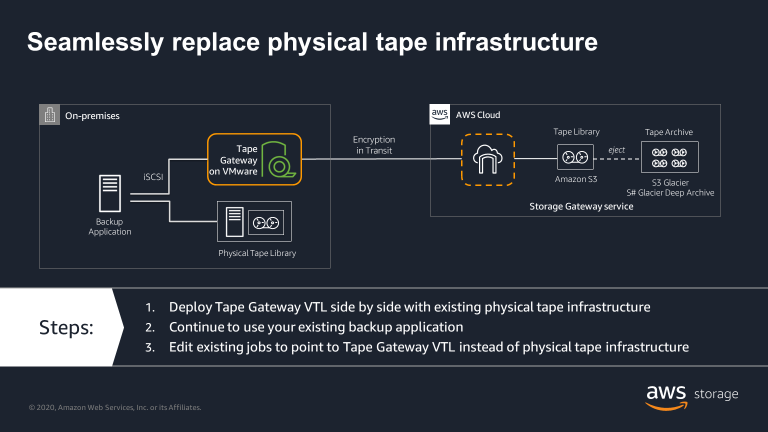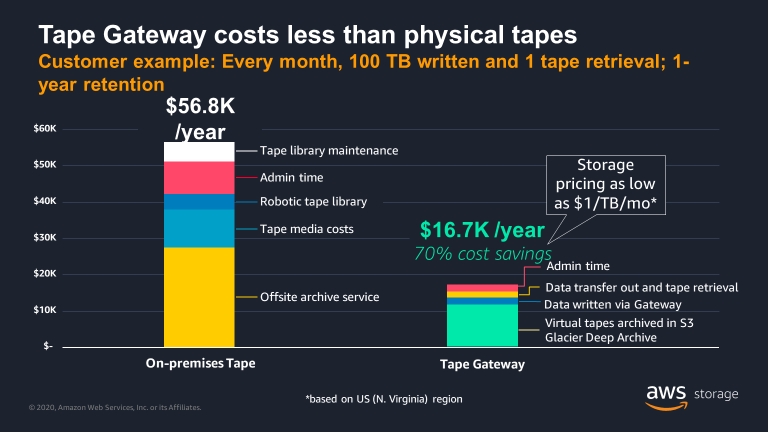AWS Storage Blog
Escaping the pain of physical tape management with AWS Storage Gateway
As customers continue their cloud journeys, they want to shrink or eliminate their on-premises infrastructure and use the cloud for their growing business needs. This enables customers to achieve more scalability, flexibility, and agility, all while lowering costs and simplifying management. Moving to the cloud is a strategic business decision that gives you more control of your operational cost, provides more insight into how to best and most efficiently plan your resourcing, and enables you to be a more influential part of your key business initiatives. Backup is often the first workload customers consider moving to AWS as they can rapidly perform a proof-of-concept and it provides immediate cost benefits while minimizing risk.
Listening to our customers, we continue to find many organizations are using physical tape infrastructure as part of their backup and archive solution. Much of the infrastructure, tape library, tape media, and offsite storage are expensive, complex to manage, and cumbersome. As this infrastructure becomes due for refresh, many customers are evaluating whether to invest in a new physical tape library or use cloud for long-term, strategic storage. Customers who are dealing with reduced capital expenditure budgets are finding it difficult to justify investment in increasing on-premises backup storage investments. These customers do not want to procure, deploy, manage, and maintain a physical tape solution.
In this blog, I briefly provide some background on AWS Storage Gateway, a service that enables you to replace your physical tape infrastructure for backups and archives. I then focus specifically on Tape Gateway, one of the Storage Gateway gateway types. We often see customers using Tape Gateway for both backups and archives. Customers use Tape Gateway as a virtual tape library with their backup application. Customers archive backups stored on-premises that they no longer need frequent access to and for which they have long-term retention requirements.
Introduction to AWS Storage Gateway
AWS Storage Gateway is a service that provides on-premises access to AWS Cloud storage. AWS designed Storage Gateway for enterprises, universities, governments, and nonprofit customers that use hybrid cloud storage. These customers have applications running on-premises with latency and compliance requirements that require hosting and operating the applications in their data centers. Despite this, they also want to take advantage of agility, scale, and durability that the AWS Cloud offers.
You can deploy Storage Gateway in your data center either as a virtual machine (VM) – supported for VMware, Hyper-V, and KVM – or as a physical hardware appliance. It connects to your data center applications using standard storage protocols, including NFS, SMB, and iSCSI. Storage Gateway offers three different types of gateways — File Gateway, Tape Gateway, and Volume Gateway. Customers use difference gateways to address various use cases for offering cloud-backed storage to on-premises applications.
Overview of Tape Gateway
Tape Gateway is a virtual tape library (VTL) backed by AWS Cloud Storage. Tape Gateway emulates a physical tape library and consists of virtual tapes, virtual media changers, and virtual tape drives. Your backup application connects to the Tape Gateway virtual tape library via iSCSI. Using Tape Gateway, backup applications write backup jobs to a collection of virtual tapes that are stored on the gateway, which are then compressed and uploaded to Amazon S3. When your backup application ejects and exports virtual tapes, Tape Gateway archives them to either Amazon S3 Glacier or Amazon S3 Glacier Deep Archive. This is all shown in the following diagram showing how Tape Gateway works:

Restoring a previous backup is a two-step process. First, if your tape is in Amazon S3 Glacier or S3 Glacier Deep Archive, you can use the AWS Storage Gateway console, AWS CLI, or API to find and retrieve the tape to Amazon S3. When the tape is available in Amazon S3, you present it to the backup application, and begin the restore. You can restore a virtual tape to a Tape Gateway running on-premises, or to a Tape Gateway running on an Amazon EC2 instance if your backup application is running in the cloud.
Benefits of Tape Gateway
Tape Gateway provides four key benefits:
Reduce cost and complexity
Tape Gateway is a drop-in replacement for your physical tape infrastructure. It eliminates the operational burden of provisioning, scaling, maintaining, and upgrading your physical tape infrastructure. Tape Gateway provides cost optimization in a scalable operational expenditure model by reducing or eliminating on-premises physical tape infrastructure. As shown in the following example from a bona fide AWS customer, Tape Gateway can help you achieve significant savings:

Simplify tape management
Tape Gateway is a managed service and offers easy management as many of our customers inform us that they can simply “set it and forget it” with Tape Gateway. Tape Gateway supports all the leading backup applications. All you manage are your virtual tapes with all your current backup workflows. You do not need to manage your own Amazon S3 buckets or set lifecycle policies to transition data. The Storage Gateway service manages all of that for you, making it easy for you to start consuming cloud storage for your backup and archive needs. Virtual tape management is even easier with automatic tape creation, since Tape Gateway automatically creates tapes for you.
Ensure security and compliance
Tape Gateway provides several security and compliance measures, which are needed by customers that operate in different industries. Your archived tapes are marked as read only, which ensures that retrieval does not accidentally overwrite the tape. Data transfer and data at rest is encrypted end-to-end. Tape Gateway is HIPAA eligible and supports PCI, SOC, and ISO compliances.
Increase performance
Tape Gateway provides you with high performance. This includes the ability to cache your most recent backups locally and offer a faster recovery so that you do not need to fetch data from the cloud as often.
Summary
In this blog post, I discussed how Tape Gateway offers better data protection than physical tapes as it emulates physical tape libraries, removes the cost and complexity of managing physical tape infrastructure, and provides more durability than physical tapes. Your tapes are stored in Amazon S3, which offers 11 9’s of durability, and your backed-up application data is stored across at least three Availability Zones. Availability Zones give customers the ability to operate production applications and databases that are more highly available, fault tolerant, and scalable than would be possible from a single data center. Finally, Tape Gateway optimizes your cost by offering a pay-as-you-go purchase model and eliminates the need to make large upfront capital expenditure investments in on-premises physical tape infrastructure. Tape Gateway compresses and stores virtual tapes in the lowest cost storage classes making it feasible for you to retain long-term data in the cloud at a very low cost. With managing on-premises tape library no longer a requirement, and with increased savings, customers can focus on core competencies and innovation rather than burdensome tape archives.
Getting started with Tape Gateway
Customers such as Southern Oregon University, Ryanair, and many others have switched to using Tape Gateway for long-term data retention. These customers have achieved higher levels of data protection, simplified backup management, and lowered overall storage costs.
It is easy to get started with Tape Gateway using the Tape Gateway implementation guide. You can find more getting started information in this webinar:
Finally, if you would like more information on AWS Storage Gateway and Tape Gateway, check out the following resources:
- AWS Storage Gateway product page
- AWS Storage Gateway getting started guide
- Backup and Restore with AWS
- Data archiving with AWS
- Blog: How to easily replace physical tape-based backups with Tape Gateway
- Blog: Back up your on-premises applications to the cloud using AWS Storage Gateway
Thanks for reading this blog post. If you have any questions or comments, please don’t hesitate to leave a comment in the comments section.